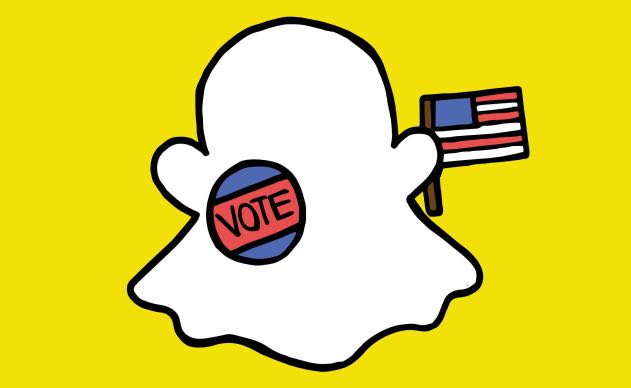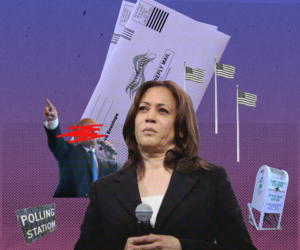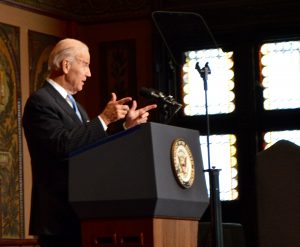As the United States swiftly approaches perhaps the most consequential presidential election in recent history, voters are being flooded with information as news outlets compete to reach people in the most unique way. Snapchat, in more ways than one, is winning that race.
The social media app—once primarily known for its disappearing selfies, daily streaks, and dog-eared filter—is now a leading medium to relay current events and election news to young voters. “Good Luck America,” Snapchat’s daily news show, keeps its users informed on political news across the country. The show is hosted by Peter Hamby, 39, a Georgetown graduate (COL ’03) and former sports editor for the Voice. Hamby left his job at CNN as a national political correspondent in 2015 to take up the role of Snapchat’s Head of News.
“Snapchat was so exciting at the time,” Hamby said. “It was blowing up in a cool way, and I just wanted the opportunity to help create something new and different.”
Even back in 2015, Hamby saw a trend: the younger generation spends much more time scrolling through their phones than reading newspapers or watching televised news. Phones are the primary means of accessing news for 69 percent of people under 35 years old. And nearly half of Generation Z, those born between 1996 and 2015, consume news on their smartphones when they wake up in the morning. Snapchat saw these changing media habits as an opportunity to formulate a new medium to communicate political news to a younger generation. Hamby, a proponent of news’ value on social media, was specifically hired by the company to build the new Snapchat news medium from scratch. Hamby hired his own staff and devised a short-form, analytical show geared toward Generation Z and Millenials. Since its launch in January of 2016, “Good Luck America” has racked up almost 2.4 million subscribers—and that number is only rising.
“We’ve really been mindful of creating a form of journalism that is accessible to people according to their daily lives, it’s portable, it’s entertaining,” Hamby said. “News doesn’t have to be a stuffy, 10,000-word article. It can be deconstructed and reassembled in a way that fits into people’s lives, and I think that I’ve definitely done that.”
In the age of “alternative facts” and internet misinformation, many voters are leery of the validity of news outlets. According to a recent Gallup poll, 60 percent of Americans have either little or no trust in mass media. Many television journalists have morphed into television personalities; likewise, many news writers are starting to seem more like columnists. In an institution with declining public confidence, Hamby hopes “Good Luck America” can provide political news without the punditry, opinion, and crosstalk found elsewhere.
“News these days, especially with social media and phones, is just ambient and noisy,” Hamby said. “People are looking for some sense of authority, some credible news source they can hold onto, and have the news explained to them.”
Hamby built his enormous audience in large part due to his ability to report fair and serious information in a way that entertains. “Good Luck America” episodes are frequently interjected with funny statements, politicians’ gaffes, or memes to keep the content relatable to their younger viewers. Hamby also interviews politicians and public servants from both sides of the aisle to offer different perspectives to his audience. In April, he asked Dr. Anthony Fauci about COVID-19 mitigation and misinformation. In May, he pressed former Vice President Joe Biden on his campaign as the Democratic nominee for President. And in September, he spoke with Republican South Carolina Senator Lindsey Graham about his reelection campaign. Hamby has covered all angles of the American political world, exposing “Good Luck America” viewers to varying biases and perspectives—which he believes to be the first step towards a politically informed electorate.
“In an era when people are very much in their media bubbles, they appreciate seeing viewpoints other than their own, and they appreciate somebody who has access to these politicians but doesn’t take himself too seriously,” Hamby said.
Snapchat has also used this appeal to contribute to a larger purpose: voter registration. In the past year, Snapchat helped register over 1 million new voters, with more than 80 percent of them under the age of 30. Hamby and his show were integral to this feat, as he candidly encourages his viewers to “swipe up now and get your sh– together” at the end of each episode. Young people who listen to Hamby’s advice are not only equipped to use their voice on social media but at the ballot box as well.
“Millennials and Gen Z are the largest voting bloc in the country and are the cultural tastemakers,” Hamby added. “The people that run our politics in Washington are much older than that, and they have to reckon with the fact that this younger generation has a lot of cultural power. I’m excited to see what they do with it.”
“Good Luck America” is not alone in its effort to encourage younger generations to get out the vote. It’s part of a recent widespread push to encourage youth engagement in the political processes through various forms of popular media. Other efforts to inform and energize the younger voters include conservative commentator Ben Shapiro’s podcasts, Representative Alexandria Ocasio Cortez’s Instagram livestreams, and the “Get Out the Vote” initiative. These compounded efforts have certainly paid off in engaging and activating young people. A new Vice News/Ipsos poll found that four out of five people between the ages of 18 and 30 either plan to vote or have already voted in the 2020 Election. This year’s surge in voter registration and turnout is sure to impact the polls—if not the entire outcome—of the election. Over 90 million ballots have been counted nationwide thus far, still with a day to go until the official Election Day.
“Young people aren’t going away,” Hamby said. “They’re loud in a good way and their perspectives are so much different—on climate change, on the economy, on the nature of work, on education, on guns, on social justice.”
With heightened attention on this particular election, Hamby anticipates a record-breaking audience for his election night coverage on Tuesday, Nov. 3. More than 10 million people watched Hamby’s 2018 midterm election coverage, and he believes even more will watch this time around. And it’s possible that his election coverage won’t end Tuesday night. This year’s increase in mail-in ballots due to the COVID-19 pandemic may postpone the results weeks after the official election is over, leaving Americans on edge. As Hamby says, “Good luck, America!”





